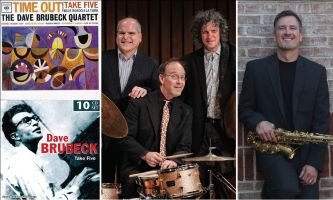As noted by Keowee Chamber Music Festival director Kate Steinbeck to a crowd of 85+, this was a glorious fall day right at the peak of colorful foliage for this altitude. In the Cathedral of All Souls, built by George Vanderbilt and positioned literally across the street from his famous Biltmore Estate, flutist Steinbeck, Cara Jenkins, oboe, and Dewitt Tipton, piano, gathered to present a balanced and esoteric chamber program called “Recollections.”
Jenkins was first up, performing Madeleine Dring’s four-minute “Italian Dance” (1960) with Tipton at the piano. This is a delightful romp reminiscent of a renaissance salterello with modern harmony.
Next came the Sonata for flute and piano, Op. 77 (1924), by Belgian composer Joseph Jongen (1873-1953). On paper this looked like Poulenc but, as Tipton later pointed out, it sounded more like a combination of Debussy and Ravel. Jongen composed from the age of 13, had a certain distinction for brilliant fugue writing, and won the Belgian Prix de Rome in 1894. This 30-minute, four-movement work is a tour de force for flute and piano, and both artists performed it with impeccable ensemble, intonation and articulation. Steinbeck and Tipton will record it in December.
After intermission, Jenkins returned to perform the Sonata for oboe and piano, Op. 166, by Camille Saint-Saëns. This three-movement work, written in 1921, started off with a distinctly baroque feel, then morphed into more modern harmonies and structure. The key of D major seemed to resonate the entire room to the point of extreme, and of course the oboe can have a penetrating presence. Jenkins delivered her part with virtuoso technique, notable in effortless leaps of register, and her ensemble with Tipton was seamless.
Next came Joueurs de Flûte, Op. 27 (1924), by Albert Roussel (1869-1937), a set of five character sketches titled, “Pan,” “Tityre,” “Krishna” and “Mr. de la Péjaudie.” Steinbeck gave these brief pieces every ounce of value in both phrase and ensemble with Tipton. Roussel had an interest in eastern literature and music, thus “Krishna” is the word for flutist or flute.
The program concluded with the five-movement Miniatures, for flute, oboe and piano, by American William Grant Still (1895-1978). Here the composer wrote sketches for the funny bone: “I Ride an Old Paint,” “Jesus is a Rock in the Weary Land,” “Yaravi” based on a folk tune from Peru, “A Frog Went A-Courtin,” and “Adolorido,” from Mexico. Jaunty rhythms and fresh melodic direction distinguished this group from the previous French influences, resulting in a good set where the reed and wind instruments matched tone and intonation with the piano.
I would say this was a great program, and on paper it was, but regrettably the Cathedral of All Souls is simply not the place for music unless a brass quintet or louder is the featured act. The site is a romantic notion, a historic structure in an historic district of Asheville, and its distinct architecture beckons from afar. However, there is no escaping the fact that outside traffic noise intrudes into the space – a space already swimming with four square acoustic challenges and echo delay. The players did their part to work around these problems, however during the pauses or quiet passages truck noises still intrude, and the church bells still chime at their appointed times.
We would like to hear this program, or certainly these players, again, in a different venue.











